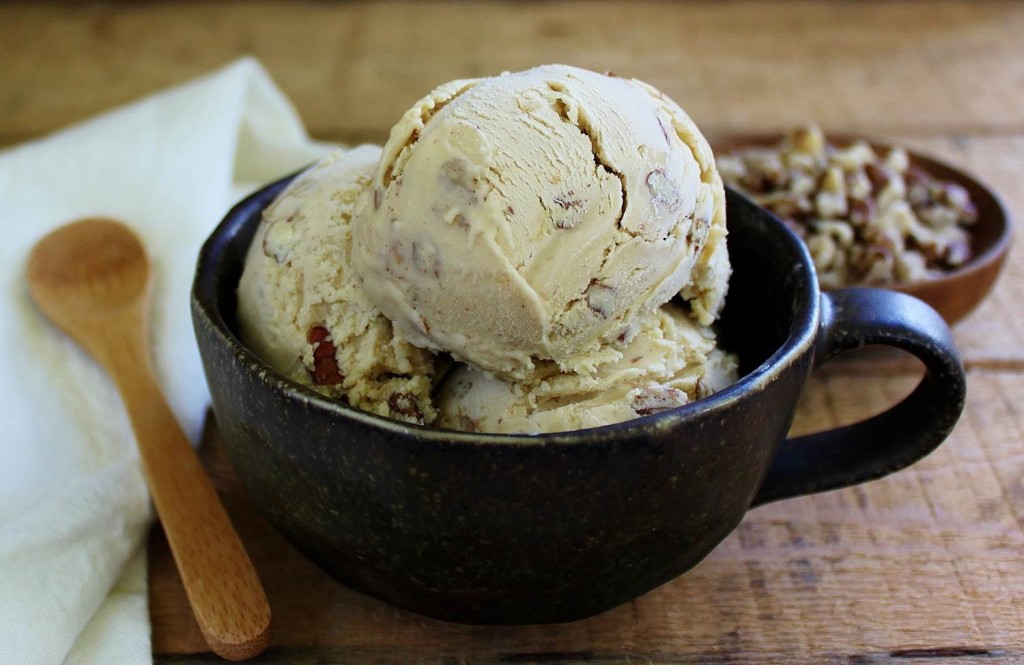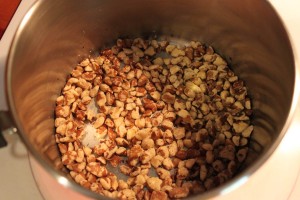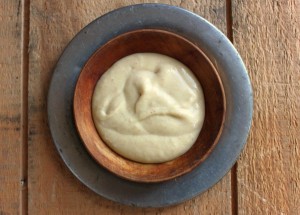Black walnuts: Either you love ’em or hate ’em, right? There may be a good reason for that division, as you’ll read later on. In this recipe, toasting the nuts mellows the flavor. Brown sugar and cinnamon go especially well with them, to make this black walnut ice cream recipe stand out from all the others. But feel free to experiment with other spices, and maybe even citrus zests. Black walnuts are not usually available at the local grocery store, so to get them, you can forage for them or buy them online.
Are black walnuts supposed to be bitter?
That depends on who you ask. I don’t think I know of any other food that divides people as much as the black walnut. Opinions range from incredibly delicious to bitterly vile, and many people seem to fall into one extreme or the other. And it’s not just that some people hate all nuts. Our family always has several different kinds of nuts on hand, unsalted and unsweetened, and we all like them and eat them regularly. But we’re divided, extremely so, over black walnuts. This baffled me for some time, because I taste the bitterness and could not imagine anyone not noticing it.
Recently I explained this mystery to my daughter Alison, who was immediately reminded of an interesting exercise in her AP biology class. She says there is a gene that gives people the ability to taste certain bitter plant compounds. 75% of people have the dominant form of the gene, and the remaining 25% have the recessive form. It’s called the PTC gene, because you can test for it by tasting the chemical phenylthiocarbamide (PTC). If you have the dominant form of the gene, PTC and certain plant compounds taste bitter. If you have the recessive form, PTC and certain plant compounds are tasteless.
So Alison’s hypothesis is that black walnuts contain one of those compounds that tastes bitter only to people who have the dominant form of the PTC gene. Seems like a reasonable explanation for the two camps into which black walnuts divide us, right? At least based on my family’s data point. Alison was one of the few students in her biology class who could not taste PTC, and she also perceives no bitterness in black walnuts. In fact, she thinks they taste much better than English walnuts. My husband agrees with her. My son and I, on the other hand, taste extreme bitterness….But not if we take measures to reduce the bitterness. Read on.
You can reduce the bitter flavor of black walnuts by toasting them. It’s counter-intuitive, because toasting intensifies the flavor of other nuts. But in the case of black walnuts, the bitter flavor cooks out….Unless, of course, you cook them for too long and burn them. Burning increases the bitterness. So you have to cook them very carefully, and I find that it’s more easily done on the stove top than in the oven.
In this recipe, toasting mellows the nuts and glazing adds a pocket of sweetness.
Makes about a quart of ice cream
Toasting and glazing the black walnuts
- 2/3 cup chopped black walnuts
- 1 and 1/2 tbsp butter
- 1 tbsp plus 1 tsp brown sugar
- Dash of cinnamon
- Dash of salt, if butter is unsalted
- Toast the nuts in a small saucepan over medium-high heat, stirring constantly, until nut papers begin to shed and nut meats begin to slightly brown. Some of the nut papers might burn, but be careful not to burn the nut meats!
- Remove from heat and pour them onto a clean towel.
- Fold the towel over the nuts and rub the nut papers off. (You need to get rid of any burnt nut papers, which will be bitter.)
- Place the naked nuts into a clean small saucepan, and add the other ingredients.
- Heat and stir until butter is melted and all ingredients well blended.
- Spread onto a foil lined plate and place in the freezer for at least 30 minutes.
- Transfer to a small container, breaking them up as necessary, and refrigerate until ready to use.
Black Walnut Ice Cream
- 3 large eggs
- 2/3 cup brown sugar
- 1/2 tsp cinnamon
- Pinch of salt
- 2 cups heavy cream
- 1 cup whole or low fat milk
- 2 tbsp corn syrup
- 1 batch of toasted, glazed black walnuts (above)
- In a medium bowl, whisk eggs until yolks and whites are well blended, and set aside.
- In a small bowl, whisk together sugar, cinnamon, and salt until cinnamon is well distributed.
- In a 4 qt saucepan, heat cream, milk, and corn syrup over medium-high heat, stirring frequently, until it begins to simmer.
- Add sugar/cinnamon mixture and stir until sugar is dissolved.
- Remove from heat, and temper the eggs by drizzling about 1 and 1/2 cups of the hot cream mixture into the eggs while you whisk the eggs vigorously.
- Carefully pour the egg mixture into the 4 qt saucepan with the remaining hot cream mixture.
- Cook over medium-low heat, stirring constantly (preferably with a heat proof rubber spatula, but a metal or wooden spoon will do), until mixture thickens and reaches a temperature of about 170-175 degrees F. Scrape the bottom of the pan as you stir. It usually takes 8-10 minutes to thicken, but this varies, depending on your heating element and your pan. Mixture should be noticeably thicker than the raw cream mixture.
- Remove from heat and immediately pour through a fine mesh strainer, into a clean bowl.
- Refrigerate immediately, or pre-cool in a cold water bath for about 30 minutes, and then refrigerate. Stir occasionally for the first half hour of cooling.
- Keep refrigerated until fully cooled, at least 4 hours. It will thicken while cooling until it reaches the consistency of a pourable pudding.
- Churn in ice cream maker according the manufacturer’s directions.
- Stir in glazed nuts, as you transfer to a storage container.
- Freeze until ready to eat or until desired firmness.
Shared on:













The inherent bitterness in black walnuts is sometimes acerbated by the method of harvesting and curing.
Prompt harvest is key for maintaining peak kernel color and flavor. The longer a fully ripened husk remains on the nut, the darker and more bitter the kernels will become.
Some find it easier to harvest black walnuts after the husk has become black and mushy, one has only to pick up the nuts out of the mush eliminating the hulling process.
Personally I will eat small pieces of walnut meat during cracking.
Any off taste nuts are discarded.
It’s amazing the range of flavor and bitterness of nuts processed the same time and from the same tree.
Never attempted roasting black walnuts, thanks for the information.
Thanks – I had read that online but have not experimented with dehusking time. It does seem, though, that some people don’t notice any bitterness at all. They all taste terrible to me until roasting, at which point I find them edible but still not up there with hickory nuts or hazelnuts. I even purchased some online to see if there was something different, and to me they are still horrible raw, while husband and daughter like them.
This looks wonderful and your photo is beautiful! I’ve chosen this as one of our features at tomorrow’s HomeAcre Hop. Thank you so much for sharing. We hope you’ll come back again tomorrow.
Thank you so much, Jenny!
Pingback: The Thankful HomeAcre Hop | Black Fox Homestead
Pingback: 15 Trees for a Wildlife-Friendly, Edible Landsape - One Acre Farm
fyi – Black Walnut is featured in the “Species Spotlight” in the September, 2014 edition of the Massachusetts Citizen Forester newsletter. Here’s the link: www (dot) mass.gov/eea/docs/dcr/stewardship/forestry/urban/citizen-forester/cf2014-sept (dot) pdf The Black Walnut article begins on p.3, and includes a large section on processing and eating the nuts (including two recipes), contributed by yours truly.
Thanks, Russ, that was a very informative article.
Pingback: How to Harvest and Crack Black Walnuts
Fascinating. I was excited to find our hundred something walnut trees we planted produced nuts this year. I excitedly plucked some off the tree (which I later discovered those nuts weren’t ripe) and picked them off the ground. I carefully proceeded to process them after watching videos and reading articles. After curing them three or four weeks, I finally cracked one open. Everyone tried them and we all found them to be extremely bitter! What a disappointment! I let them cure another few weeks, hoping they’d be less bitter, but they weren’t. I decided to toast them and was pleasantly surprised. That helped the bitterness quite a bit, but the aftertaste remains bitter and strong. I love your daughter’s theory! That makes so much sense! I’ll look forward to trying your recipes – if it helped your taste buds, it may help mine! Thanks